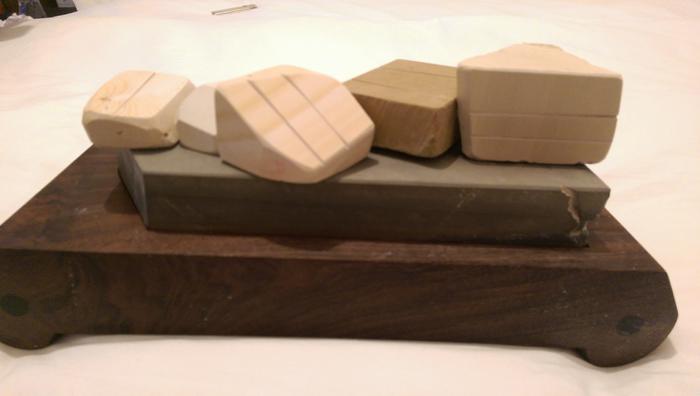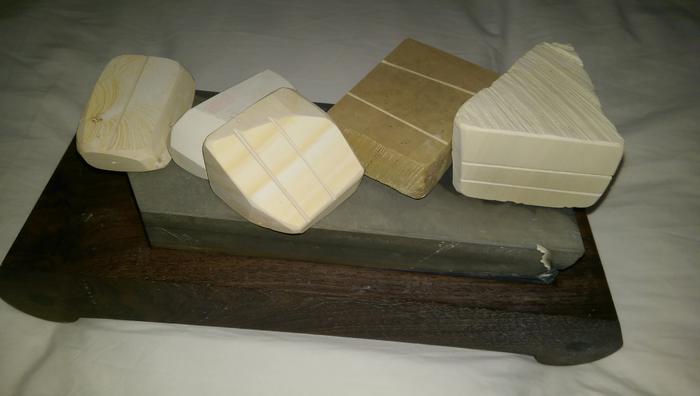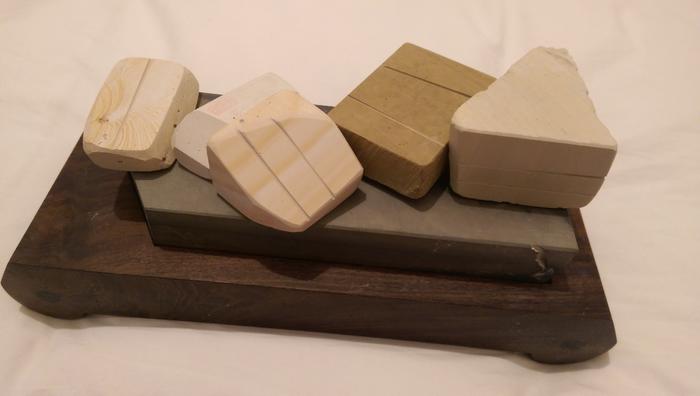Results 1 to 10 of 14
Thread: Tried Some Thing New
-
06-20-2015, 05:48 PM #1
 Tried Some Thing New
Tried Some Thing New
Normally I hone with synthetics and finish on my Nakayama Maruka and I get excellent results.
Recently I bought the Chosera 10k so I went from Shapton's to Chosera 1/5/10k/Nakayama.
I also have a full range of Naguras which I've been experimenting with.
The other day I thought lets try to set the bevel on the 1k then go straight to the Nakayama and progress through the full set of Naguras .
It took a long time and after a strop it was popping hairs, tree top style, which shocked me because when I hit the 4/5k synthetic I remove quite a bit of metal but on the natural I cant see any metal being removed, unless that what darkens the slurry?
Today I had a shave with blade in question. It was jaw droppingly amazing. It removed every trace of hair ATG without stuttering but what was noticeable was how the blade didn't feel sharp at all. It was like dragging a smooth piece of plastic over my face.
Maybe going 1k to Jnat is nothing new to some, I don't know, but it was a shot in the dark for me that paid off.



Last edited by JOB15; 06-21-2015 at 12:02 AM.
-
06-20-2015, 11:46 PM #2

It's nothing new, or unusual. Alex Gilmore (thejapanstone.com) has many videos going from a 1k to a finisher with only a tomo nagura. That's do-able, but I usually put a suita in between the 1k and finisher if I don't do a Mikawa nagura(s). Or just refreshing the tomo slurry a second time usually does the trick.
When I was learning to use Jnats, Alex would often tell me that maybe the stones were cutting faster than I thought they were, and that can be especially true if the color of the hone is darker and masks the slurry loading with swarf.
The edge you're feeling is classic quality Jnat. I have a barber size Nakayama which produces a smooth edge very much like a good coticule edge, and I've been told that by others who have tested these edges. It's like shaving with the spine of a butter knife. Oddly enough, I get more tiny "oops" with these edges because they kind of lull you into not getting a good stretch or just being a little careless. In spite of the smoothness, the edge is very sharp, HHT4+.
Cheers, Steve
-
The Following User Says Thank You to Steve56 For This Useful Post:
JOB15 (06-21-2015)
-
06-21-2015, 12:01 AM #3

Previously I was going from the 8k Shapton onto the Nagura progression so I had no idea you could go from the 1k.
I do notice on the earlier Naguras I can turn the slurry dark really quickly .. I thought that was the slurry breaking down but now I understand that it is swarf.. Come to think about it I can turn the tomo dark quickly too.
Maybe that means my stone is fast so I should use weaker slurries?
One thing that gets to me is the Mejiro , its so hard to get a slurry from it, any tips? Hardly any water is the only thing that seems to kind of work, still takes an age though.Last edited by JOB15; 06-21-2015 at 12:09 AM.
-
06-21-2015, 12:32 AM #4I used Nakayamas for my house



- Join Date
- Aug 2009
- Location
- Des Moines
- Posts
- 8,664
- Blog Entries
- 1
Thanked: 2591
-
The Following User Says Thank You to mainaman For This Useful Post:
JOB15 (06-21-2015)
-
06-21-2015, 12:33 AM #5

Yes, the dark is swarf. The whole idea of a Mikawa nagura progression is to do away with everything but the finisher, though I prefer a synthetic bevel setter. Nothing like getting off to a good start! If you have a botan, it's likely coarser than your 8k Shapton.
I use thinner slurries than most folks do and get great results, so give it a whirl. Nagura slurry does three things, it provides grit (especially with the Mikawa progression), provides lubrication to prevent skipping and burnishing, and it "energizes" the host stone into releasing more slurry of it's own.
Sounds like you mejiro is a good one, i have one that's hard too, and both koma I have are even harder. The only trick is patience. Don't press too hard, just keep lightly rubbing. My koma are hard enough to basically be a natural "diamond plate", they're harder than most of my hones though they probably do release some grit.
Cheers, Steve
-
The Following User Says Thank You to Steve56 For This Useful Post:
JOB15 (06-21-2015)
-
06-21-2015, 12:42 AM #6I used Nakayamas for my house



- Join Date
- Aug 2009
- Location
- Des Moines
- Posts
- 8,664
- Blog Entries
- 1
Thanked: 2591
Incorrect, all naguras have same size particles, difference is how much they can break down in use.
the base stone should not be releasing slurry, the point of it is to refine the slurry from the nagura/tomonagura to the finess of its surface. If the base stone will be releasing slurry that will result in boor edge refinement.Nagura slurry does three things, it provides grit (especially with the Mikawa progression), provides lubrication to prevent skipping and burnishing, and it "energizes" the host stone into releasing more slurry of it's own.
Naguras have to be soft enough to release slurry easily, best ones are.
@ OP: you can round a corner on your Mejiro and use that corner to make the slurry it will be a lot easier. Make sure you are not going to rub any sharp edges on your stone , it may get scratched.Last edited by mainaman; 06-21-2015 at 01:31 AM.
Stefan
-
The Following User Says Thank You to mainaman For This Useful Post:
JOB15 (06-21-2015)
-
06-21-2015, 01:17 AM #7

I believe that whether the particles break down or don't break down is not settled science.
There's allgedly a paper in Japanese that advances the premise that the grit is all the same and only the hardness varies. I have not seen the paper or a translation, but I can understand that, maybe it's why the finish on novaculites seem to affect the tesults as much as users report.
But Todd Simpson at "Science of Sharp" has SEM photos of Jnat slurry showing it doesn't break down:
https://scienceofsharp.wordpress.com...ry-break-down/
So if Jnat particles are all the same and slurry doesn't break down, then all Jnat hones are the same. We all know that isn't true in a practical sense.
But all it means is that we don't yet fully understand what's going on.
Cheers, SteveLast edited by Steve56; 06-21-2015 at 01:18 AM. Reason: Typo
-
06-21-2015, 01:47 AM #8I used Nakayamas for my house



- Join Date
- Aug 2009
- Location
- Des Moines
- Posts
- 8,664
- Blog Entries
- 1
Thanked: 2591
Steve,
the grit is the same the difference is how easy the break down happens, which is a function of the binder of the stone. If one is dealing with a soft stone, with weak binder, new abrasive particles will release from the stone all the time thus the slurry will never refine. As the hone becomes harder less and less slurry will be released which will allow for the initial slurry to break down more. The hardest stones release nothing and the slurry that is deposited on them gets refined by grinding between the bevel and the stone. This fact is the basis of the use of nagura and tomonagura. On a very hard base stone one would use a progression of naguras to refine the edge, each nagura will break down with different speed, which will simulate the use of different grits. One can achieve the same result with only one nagura by doing several dilutions and/or working on the slurry long enough. All of this follows from the fact that the abrasive particles are similar in size but the speed of break down varies. The break down happens by shearing , the abrasive platelets become thinner, that is how the bevel and the edge get refined, by inducing shallower scratches this way.
The piece of literature you are referring to is a book about J-Nats written by the Kyoto Stone Association, in it all things J-Nats are discussed. I have not seen translation, but Maksim showed me images of some pages with pics of slurry particles etc. I hope this book gets translated one day ,it will be a very good reference material.
As for the linked website, I would not read much into the "discoveries" there, the experimental procedures are not well explained, and I am sure the experimental design was not optimal by any means. That would lead to inconclusive results easy.Stefan
-
06-21-2015, 02:02 AM #9

Hi Stefan,
This isn't it is it? Image attached.
BTW, I've been thinking I remember you from Fred's a while back before he got hacked and didn't re-up the forum. Were you there?
Cheers, Steve
-
06-21-2015, 02:54 AM #10I used Nakayamas for my house



- Join Date
- Aug 2009
- Location
- Des Moines
- Posts
- 8,664
- Blog Entries
- 1
Thanked: 2591


 LinkBack URL
LinkBack URL About LinkBacks
About LinkBacks






 Reply With Quote
Reply With Quote
